The Strange Invisibility of a Black Kat in Front of a Black Sheet
I taught George Herriman’s Krazy Kat for the first time last semester to my advanced comics class. It was also the first time I came across the Sunday comic published in the San Francisco Examiner on July 11, 1919. I now plan to include it in the first chapter of my work-in-progress The Color of Paper. Here’s a first draft of my analysis:

Likely the first critic to analyze the series, Summer Baldwin wrote in 1917 that “Mr. Herriman’s medium is the pen and ink sketch,” noting a central contrast: “Krazy Kat is black,” but “Ignatz Mouse is done in line,” and the “other characters are also done in line” (801).

More precisely, Herriman renders Krazy Kat as a tightly cross-hatched and so nearly opaque ink shape, with minimal unmarked page area visible between the figure’s interior black marks, sometimes more lightly in the area of the stomach suggesting lighter fur. In contrast, Herriman composes Ignatz’s head and torso as exterior black contour lines with minimal internal marks delineating three-dimensional features. Ignatz’s limbs, fingers, and tail are single lines.
Other characters, including Officer Pupp, may also include minimal cross-hatching to suggest shadow, including along Pupp’s lower torso creating the impression of a protruding stomach. Herriman likely drew Krazy Kat similarly, what Baldwin terms “in line,” before adding “black” cross-hatching.
Baldwin also notes that Krazy Kat’s “face is white, with two black dots for eyes, and a thick black line for a nose” (801). That “line” is a double line or a circle depending on whether the nose is rendered in profile or as if viewed head-on, and the dots appear at the center of unmarked areas enclosed by two circles. Herriman also draws a backward protruding bow around the character’s neck, which, in Baldwin’s analysis would also be “white” since the two sides of the bow are drawn only “in line.”
The details are significant because the 1919 comic disrupts them.
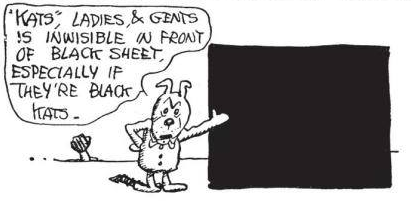
Officer Pupp announces in the first image: “‘Kats,’ ladies, & gents, is invisible in front of black sheet, especially if they’re black kats.” His hand extends in front of the “black sheet,” revealing that his body is diegetically opaque, though discursively the interior area of his body is the page surface. The page areas visible outside of his body are discursively identical but diegetically distinct, representing either sky or ground depending on whether above or below horizon lines.

In the second image, Pupp instructs Krazy Kat: “Open them eyes!!” and Herriman draws two white circles punctuated with tall black pupil-representing shapes. Herriman does not include Krazy Kat’s “white” face or bow, nor the line-like areas of his stomach normally visible between crosshatches. This is presumably because he has only drawn the character’s eyes. Krazy Kat is not “invisible” because a black body is drawn “in front of” or even discursively surrounded by a black object but because the body is not drawn at all.

When Ignatz hands Krazy Kat what is apparently a glass milk bottle, the object appears to be opaque white in front of the black sheet – though once emptied, the bottle remains opaque white.
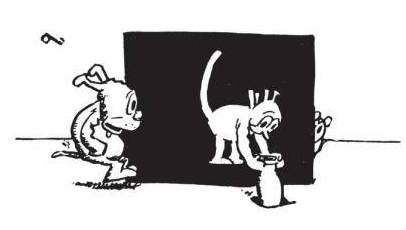
Krazy Kat’s crosshatched paw partially blocks the bottle when their body is black, and again as their body grows incrementally white as though filling like a container with liquid.

The filling effect is paradoxical though, since Herriman does not render the liquid pouring through their body, presumably because the body is still diegetically opaque black while discursively it is undrawn and then partially drawn. When fully drawn, Krazy Kat resembles Officer Pupp, both now “done in line.” Krazy Kat, however, stands in full contrast to the “black sheet,” reducing the contour drawing effect. Herriman also crosshatches no shadows within the body, further flattening the image.
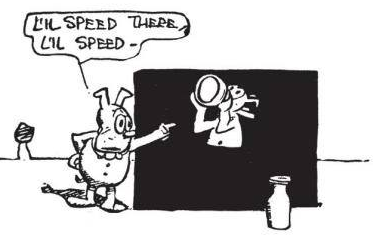
When the character drinks from an “INK” bottle, the ink is presumably black, though the bottle is the same opaque white as the milk bottle. The figures also seem to hover several vacillating inches off the ground, and while the other characters and objects (including both emptied bottles) cast crosshatched shadows beneath or beside them, Herriman draws no marks in the areas representing the three-dimensional space before the sheet. The comic offers no diegetic explanation for the impossibilities, adding to the implicit effect of Krazy Kat appearing not diegetically “in front of black sheet” but discursively within a black panel.
The black panel also reveals other of Herriman’s drawing norms.
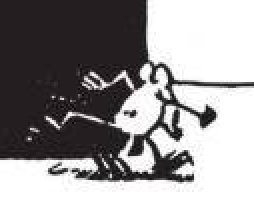
Though still “done in line,” when drawn diegetically in front of the black sheet, Ignatz’s limbs and tail are not black lines but white ones. Where other “white” objects are rendered by drawing black marks around them, these white areas do not appear to have been drawn directly and so were, prior to the newspaper printing process, initially made with white ink applied on top of the black ink of the black panels. Ignatz’s appendages, being only the width of a line, require contrast to be legible. As a result, since a white mouse is not diegetically invisible in front of a black sheet, the figure’s black lines must become discursively white to remain visible.
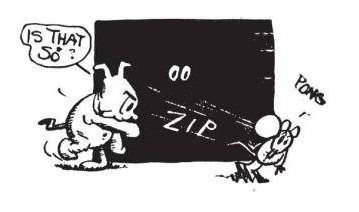
Similarly, the zip lines and onomatopoeic “ZIP” within (or diegetically “in front of”) the black panels must be rendered in white too, as when Officer Pupp throws an unidentified white object at Ignatz in the fifth image. Though the object is likely negative space, the motion lines and the lines of the letters were likely rendered in white ink.

The thinness of those lines creates a discursive challenge. In scans of the San Francisco Examiner newspaper page, the lines are either mostly absent or obscured in the digital reproduction process. If absent, then the marks were obscured in the original printing process due to the thinness of the lines. The paper likely absorbed the black ink surrounding it.

Presumably working from either Herriman’s original art or from a better reproduction, the Fantagraphics reproduction of the page includes white motion lines in images five, six, and fourteen. The Fantagraphics edition is also printed on white paper, dissimilar to the gray of the newspaper stock. As a result, the white opaque objects appear discursively white too, and so the milk inside the milk bottle is the actual color of milk. Ignatz and Officer Pupp are also now white – a discursive quality that creates ambiguous diegetic ones. Is Ignatz a white mouse or a gray mouse? Is Officer Pupp a white dog or a gray dog – or a dog of some color not representable in a black-and-white image?
When Herriman later began producing color comics, Pupp is revealed to be wearing a blue uniform. Was his diegetic appearance therefore always blue, even prior to Herriman’s later discursive addition?

Chris Gavaler's Blog
- Chris Gavaler's profile
- 3 followers



